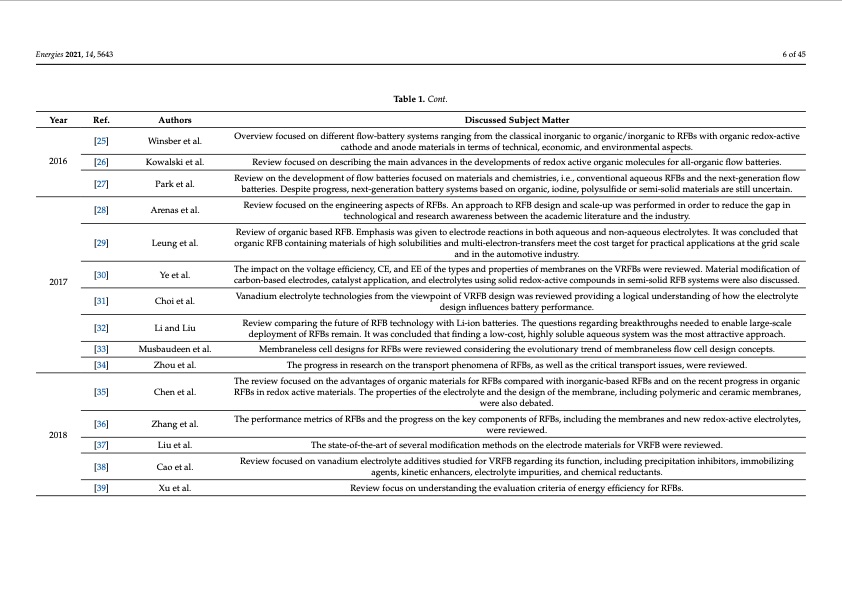
PDF Publication Title:
Text from PDF Page: 006
Energies 2021, 14, 5643 6 of 45 Table 1. Cont. Year Ref. [25] 2016 [26] [27] Authors Winsber et al. Kowalski et al. Park et al. Arenas et al. Leung et al. Ye et al. Choi et al. Li and Liu Musbaudeen et al. Zhou et al. Chen et al. Zhang et al. Liu et al. Cao et al. Xu et al. Discussed Subject Matter 2017 [28] [29] [30] [31] [32] [33] [34] [35] [36] [37] [38] [39] Overview focused on different flow-battery systems ranging from the classical inorganic to organic/inorganic to RFBs with organic redox-active cathode and anode materials in terms of technical, economic, and environmental aspects. Review focused on describing the main advances in the developments of redox active organic molecules for all-organic flow batteries. Review on the development of flow batteries focused on materials and chemistries, i.e., conventional aqueous RFBs and the next-generation flow batteries. Despite progress, next-generation battery systems based on organic, iodine, polysulfide or semi-solid materials are still uncertain. Review focused on the engineering aspects of RFBs. An approach to RFB design and scale-up was performed in order to reduce the gap in technological and research awareness between the academic literature and the industry. Review of organic based RFB. Emphasis was given to electrode reactions in both aqueous and non-aqueous electrolytes. It was concluded that organic RFB containing materials of high solubilities and multi-electron-transfers meet the cost target for practical applications at the grid scale and in the automotive industry. The impact on the voltage efficiency, CE, and EE of the types and properties of membranes on the VRFBs were reviewed. Material modification of carbon-based electrodes, catalyst application, and electrolytes using solid redox-active compounds in semi-solid RFB systems were also discussed. Vanadium electrolyte technologies from the viewpoint of VRFB design was reviewed providing a logical understanding of how the electrolyte design influences battery performance. Review comparing the future of RFB technology with Li-ion batteries. The questions regarding breakthroughs needed to enable large-scale deployment of RFBs remain. It was concluded that finding a low-cost, highly soluble aqueous system was the most attractive approach. Membraneless cell designs for RFBs were reviewed considering the evolutionary trend of membraneless flow cell design concepts. The progress in research on the transport phenomena of RFBs, as well as the critical transport issues, were reviewed. The review focused on the advantages of organic materials for RFBs compared with inorganic-based RFBs and on the recent progress in organic RFBs in redox active materials. The properties of the electrolyte and the design of the membrane, including polymeric and ceramic membranes, were also debated. The performance metrics of RFBs and the progress on the key components of RFBs, including the membranes and new redox-active electrolytes, were reviewed. The state-of-the-art of several modification methods on the electrode materials for VRFB were reviewed. Review focused on vanadium electrolyte additives studied for VRFB regarding its function, including precipitation inhibitors, immobilizing agents, kinetic enhancers, electrolyte impurities, and chemical reductants. Review focus on understanding the evaluation criteria of energy efficiency for RFBs. 2018PDF Image | PNNL Vanadium Redox Flow Battery Stack

PDF Search Title:
PNNL Vanadium Redox Flow Battery StackOriginal File Name Searched:
energies-14-05643-v2.pdfDIY PDF Search: Google It | Yahoo | Bing
Salgenx Redox Flow Battery Technology: Salt water flow battery technology with low cost and great energy density that can be used for power storage and thermal storage. Let us de-risk your production using our license. Our aqueous flow battery is less cost than Tesla Megapack and available faster. Redox flow battery. No membrane needed like with Vanadium, or Bromine. Salgenx flow battery
| CONTACT TEL: 608-238-6001 Email: greg@salgenx.com | RSS | AMP |